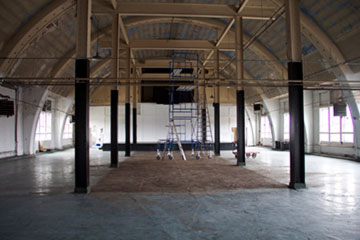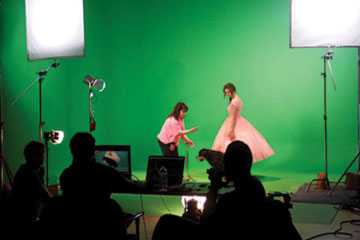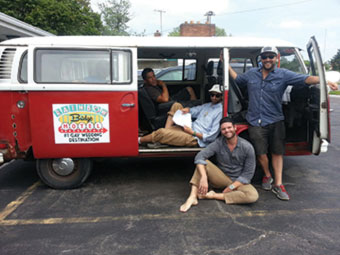Next story: See You There!
We're Rolling
by Peter Soscia

Buffalo is becoming a welcoming place for film production
Roads were shut down, vehicles were set a blaze, crowds gathered to the scene as helicopters flew overhead. This was not the sight of a massive accident or public riot, but a movie set, shooting here in downtown Buffalo.
In May, Paramount Pictures shut down a section of Route 33 to shoot multiple scenes for the upcoming Teenage Mutant Ninja Turtles 2 movie. It was not the first time Paramount had been in the Queen City. Most recently the studio was here in 2009, shooting for the Keanu Reeves movie, Henry’s Crime. However, things are different this time around for Buffalo. Although production for the Ninja Turtles movie was the most publicized by local media, according to the Mayor’s office it was just one of nine feature films that had been shot in the area this year. On August 6, Mayor Byron Brown announced the start of production for Two for One, staring and directed by Jon Abrahams (Meet the Parents, Scary Movie) making it the tenth feature film to be shot here in Western New York in 2015. By no means is Buffalo set to become Hollywood-East, but something is happened in Western New York to make the film industry go from nearly non-existent five-years-ago, to having an estimated $10 million economic impact on the area in 2015. The Queen City is quickly becoming an attractive location where both indie filmmakers, as well as studio movie and television producers want to work in and come back to.
A big factor in the fast growth of the Buffalo film industry is the same factor that leads to growth in any industry, cost of production. While large cities like Los Angeles and New York have been the hotbeds for the film industry since its inception, the cost of living in those major cities takes a toll on a film’s bottom line, and creates a financial nightmare for smaller independent productions. “I don’t think there is any way I could have made my film in New York City or anywhere else,” said Ray Guarnieri, a Clarence native who wrote, produced, and directed the indie film Buffalo Boys (2013.) The film was shot and produced in Buffalo. “Part of that has to do with the fact that the movie was based on a true story that happened [in Buffalo.] But another part is that doing a film on that small scale is difficult in a place like New York City because the cost of living is a lot higher,” said Guarnieri.
It’s more than just a cheaper cost of production that is making Upstate New York a more appealing option to filmmakers. Like many other states around the country, New York State now offers tax credits for those who choose to make their film in Upstate New York. Any film or television show that uses a qualified production facility for a portion of their principal photography qualifies for a 30 percent tax credit off the project’s production costs while shooting in New York State. “It’s one of the better tax programs available across the country. Essentially a film has to shoot one day at a soundstage to get the tax credit,” said filmmaker Garrett Vorreuter.


Locally, a building that once helped place the city on the industrial map is now helping to put it on another. Three years ago, Vorreuter was tapped to operate The Pierce Arrow Film Arts Center, a New York State certified soundstage, operating out of the former Pierce Arrow administration building on Elmwood Ave. The building served as the headquarters and production facility for Pierce–Arrow automobiles from the early 1900s until the late 1930s.
The factory layout of the building, featuring large wide-open rooms was the prefect fit for a soundstage, as Vorreuter, building owner Joseph Hecht, and others were able to create a 7,778-square-foot auditorium soundstage (meeting the size requires to become a qualified production facility), a 5,214 square-foot soundstage, as well as a 2,000 square-foot green screen stage. Vorreuter has been working in the upstate film industry for roughly five years, and used the Pierce Arrow Film Arts Center’s soundstage in July for the production of his film The Rainbow Bridge Motel. This is the first movie that he is both producing and directing, and it was a long road of working on films in Upstate New York to get to that level.
“When I started out I was doing whatever I could, there wasn’t a lot of opportunity. I think that’s why I started with The Pierce Arrow Film Center. To help create opportunity for people so they could work and learn for themselves and not just wait to get lucky,” said Vorreuter. “That’s the thing, if you don’t have an opportunity to grow and expand yourself in this industry, you won’t. Now there are many more opportunities. When I started there were no internship opportunities, and now a lot of people who have interned here have gone on to earn much better jobs than they could have otherwise.”
It’s largely believed that if you want to make a career of working behind the camera, you have to find work in a major industry hub. However, Vorreuter doesn’t see that as the case anymore. “That’s what people would tell you but the industry is leaving those places. It’s a change in the industry, it goes wherever the work can be done in the cheapest, most effective way, and people follow the work. It’s great to see that there are people making a living in the film industry in a place like Western New York,” said Vorreuter.
Matt Quinn is the Director of Photography for Two For One, which is currently shooting in Buffalo. Quinn operates FilmKiln, a local production company, and has seen first hand the shift Vorreuter is talking about. “The local industry has grown exponentially, especially in the last three years. I have friends who have gone from making $5,000 or $7,000 a year, a couple years ago, who are actually able make a decent enough living to have a life essentially. It’s not crazy money, but they are able to sustain themselves on film and television work alone,” said Quinn.


This fast local growth has created an opportunity for local workers to come together to build relationships with one another. “During this time we started building a lot of relationships with local film crews. Before this time, say 10-years-ago, everyone was sort of spread out. Now we’re filling up into these crews that are handling multiple projects at a time. What we’re seeing is a couple of little production companies that have their own things going on—combining on bigger projects when they come to town whether it be with gear rental, working on the films, helping provide crew, or location advice,” said Quinn. “It’s a really exciting time for film makers and more importantly creative people who are finding a niche working on these projects. We’re getting to a place where everyone is able to have a job and no one feels threatened by each other, it’s a cool collaborative vibe in Buffalo.”
While tax credits, a qualified soundstage, production crews working together, and companies looking for cheaper production locations have made the film and television industry viable in Buffalo, Western New York still has work to do for industry to continue this growth, and it starts with the work force. Local production crews do have a role in most projects that come to the area, but bigger projects bring in crews from out of town. The local workforce will continue to grow if local crews and companies like the Peirce Arrow Film Arts Center continue to work on projects locally, however the fastest way to grow a work force is through education.
Local colleges such as Canisius, UB, and Buffalo State continue to make strides in offering classes related to both broadcasting production and digital arts. In 2013 a big boost came to the area when New York State awarded $4.5 Million to Daemen College and Empire Visual Effects for a partnership to bring the post production company to Buffalo, and create a new Visual Effects Certificate Program at Daemen College.
“The idea was that a lot of post production work was done overseas, but that creates its own brand of hardships, such as a harsh time difference and language barriers,” said Dr. Laura Sommers, Chair of the Visual Performing Arts Department at Daemen College. “Empire Visual Effects was hoping to use some of the tax incentives that we have in New York State, plus the cheap real estate here in Buffalo to figure out a way to set up a visual effects studios here, where we have a large population of young people who are looking for jobs in the creative industries. Daemen College got involved by bringing to the State the first post production certificate program.”
Students take a series of five classes that lay the groundwork for a career in post production work, as well as an apprenticeship with Empire Visual Effects. “Typically what happens in post production is that when people are employed they go through the training process after being hired. So what we’re doing is what used to be done in studios. We’re getting [students] to an entry level, so they can be ready to gain the experience by working on jobs,” said Sommers.
Guarnieri views The Visual Effects program at Daemen as a sign of good things to come for the local film industry. “It’s huge, I think it signals some major advances in the quantity of skilled workers and the quality of the skills that Western New York film professionals have, or will have. I think that we’re going to see a strong union presence. By having union workers that are local it means that the scale of productions that Buffalo will be able to host is going to increase dramatically,” said Guarnieri.
Having local workers joining a film and television industry union is something that Quinn feels is the next big step that western New York film must take. “More of the people in the area need to get into the union. That’s the only thing I see holding us back from reaching another level of film and television in this town is having enough people in the union to warrant big projects to come to this town,” said Quinn. “It’s kind of a catch-22, big productions won’t come to your town if you don’t have enough union workers, but you can’t get enough union people unless there’s enough work. Now there’s a lot work in our town, so we need to get people in the union and then get a larger soundstage built for these bigger projects.”
While the continued growth and unionization of the workforce is key to the future of the Western New York film industry, Buffalo has had one thing working in its favor the entire time: The area itself, in both the people and the location.
“I think people in Buffalo are just really excited about anyone and any project that’s going to showcase the area, but also contribute economically and culturally to the region specifically. There’s really just a strong sense of open arms to people who are trying to do good things in Buffalo,” said Guarnieri. “Once people realize the architecture and the locations we have here, places inside the city, Niagara Falls, as well as the small towns that are close by, I think that bigger studios are going to see that Buffalo is really the biggest back lot in the United States. In turn, we’ll see a bigger influx of talent and resources coming into the area.”
blog comments powered by Disqus|
Issue Navigation> Issue Index > v14n32 (Week of Thursday, August 13) > We're Rolling This Week's Issue • Artvoice Daily • Artvoice TV • Events Calendar • Classifieds |









 Current Issue
Current Issue